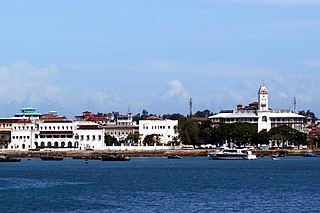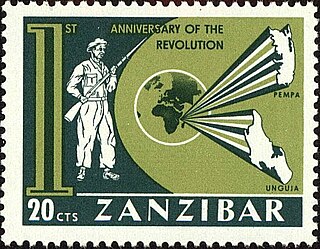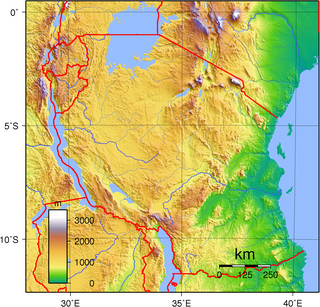Related Research Articles
The modern-day African Great Lakes state of Tanzania dates formally from 1964, when it was formed out of the union of the much larger mainland territory of Tanganyika and the coastal archipelago of Zanzibar. The former was a colony and part of German East Africa from the 1880s to 1919 when, under the League of Nations, it became a British mandate. It served as a British mir II]], providing financial help, munitions, and soldiers. In 1947, Tanganyika became a United Nations Trust Territory under British administration, a status it kept until its independence in 1961. The island of Zanzibar thrived as a trading hub, successively controlled by the Portuguese, the Sultanate of Oman, and then as a British protectorate by the end of the nineteenth century.

Zanzibar is a Tanzanian archipelago off the coast of East Africa. It is located in the Indian Ocean, and consists of many small islands and two large ones: Unguja and Pemba Island. The capital is Zanzibar City, located on the island of Unguja. Its historic centre, Stone Town, is a World Heritage Site.

Pemba Island is a Tanzanian island forming part of the Zanzibar Archipelago, lying within the Swahili Coast in the Indian Ocean.

Ujiji is the oldest town in western Tanzania and is located in Kigoma-Ujiji District of Kigoma Region. Originally a Swahili settlement and then an Arab slave trading post by the mid-nineteenth century nominally under the Sultanate of Zanzibar, the town is the oldest in western Tanzania. In 1900, the population was estimated at 10,000 and in 1967 about 41,000. The site is a registered National Historic Site.

Stonetown of Zanzibar, also known as Mji Mkongwe, is the old part of Zanzibar City, the main city of Zanzibar, in Tanzania. The newer portion of the city is known as Ng'ambo, Swahili for 'the other side'. Stone Town is located on the western coast of Unguja, the main island of the Zanzibar Archipelago. Former capital of the Zanzibar Sultanate, and flourishing centre of the spice trade as well as the Indian Ocean slave trade in the 19th century, it retained its importance as the main city of Zanzibar during the period of the British protectorate. When Tanganyika and Zanzibar joined each other to form the United Republic of Tanzania, Zanzibar kept a semi-autonomous status, with Stone Town as its local government seat.
The Province of Bumbunga was an Australian secessionist micronation located on a farm at Bumbunga near Snowtown and Lochiel, South Australia, from 1976 until approximately 2000. Its founder and only ruler was a British monkey trainer, uranium prospector, and postmaster named Alec Brackstone.

The Abushiri Revolt, also known as the Slave Trader Revolt, but generally referred to by modern historians as the Coastal Rebellion, was an insurrection in 1888–1889 by the Arab, Swahili and African population of the coast of what is now Tanzania. This coast had been leased, under protest, to Germany by the Sultan of Zanzibar in 1888. The rebellion was eventually suppressed by a German expeditionary force commanded by Hermann Wissmann.

The Anglo-Zanzibar War was a military conflict fought between the United Kingdom and the Sultanate of Zanzibar on 27 August 1896. The conflict lasted between 38 and 45 minutes, marking it as the shortest recorded war in history. The immediate cause of the war was the suspicious death of the pro-British Sultan Hamad bin Thuwaini on 25 August 1896 and the subsequent succession of Sultan Khalid bin Barghash. The British authorities preferred Hamoud bin Mohammed, who was more favourable to British interests, as sultan. The agreement of 14 June 1890, instituting a British protectorate over Zanzibar, specified that a candidate for accession to the sultanate should obtain the permission of the British consul; Khalid had not fulfilled this requirement. The British considered this a casus belli and sent an ultimatum to Khalid demanding that he order his forces to stand down and leave the palace. In response, Khalid called up his palace guard and barricaded himself inside the palace.

The Zanzibar Revolution began on 12 January 1964 and led to the overthrow of the Sultan of Zanzibar Jamshid bin Abdullah and his mainly Arab government by the island's majority Black African population.
The Anglican Church of Tanzania is a province of the Anglican Communion based in Dodoma. It consists of 28 dioceses headed by their respective bishops. It seceded from the Province of East Africa in 1970, which it shared with Kenya. The current primate and archbishop is Maimbo Mndolwa, enthroned on 20 May 2018.

Mikindani is a historic coastal town located in Mtwara-Mikindani District of Mtwara Region in Tanzania. The name comes from the Swahili word mikinda which means "young coconut trees". Therefore, the term "Mikindani', literally means "the place where there are young coconut trees" in old Swahili language. Mikindani is part of the city of Mtwara and is governed by the Mtwara Mikindani Municipal Council. The site is a registered National Historic Site.
People have lived in Zanzibar for 20,000 years. The earliest written accounts of Zanzibar began when the islands became a base for traders voyaging between the African Great Lakes, the Somali Peninsula, the Arabian Peninsula, Iran, and the Indian subcontinent. Unguja offered a protected and defensible harbour, so although the archipelago had few products of value, Omanis and Yemenis settled in what became Zanzibar City as a convenient point from which to trade with towns on the Swahili Coast. They established garrisons on the islands and built the first mosques in the African Great Lakes Region.

The Swahili coast is a coastal area of East Africa, bordered by the Indian Ocean and inhabited by the Swahili people. It includes Sofala ; Mombasa, Gede, Pate Island, Lamu, and Malindi ; and Dar es Salaam and Kilwa. In addition, several coastal islands are included in the Swahili coast, such as Zanzibar and Comoros.
The Baháʼí Faith in Tanzania begins when the first pioneer, Claire Gung, arrived in 1950 in what was then called Tanganyika. With the first Tanganyikan to join the religion in 1952 the first Baháʼí Local Spiritual Assembly was elected in 1952 of Tanganyika in Dar es Salaam. In 1956 a regional Baháʼí Assembly which included Tanganyika was elected. Later each of the constituent countries successively formed their own independent Baháʼí National Spiritual Assembly and Tanganyika, with Zanzibar, formed its own in 1964 and it and the country was renamed Tanzania. Since 1986 the Baháʼís have operated the Ruaha Secondary School as a Baháʼí school. In 2005 Baháʼís were estimated at 163,800 adherents.

Tanzanian nationality law is regulated by the Constitution of Tanzania, as amended; the Tanzania Citizenship Act, and its revisions; and various international agreements to which the country is a signatory. These laws determine who is, or is eligible to be, a national of Tanzania. The legal means to acquire nationality, formal legal membership in a nation, differ from the domestic relationship of rights and obligations between a national and the nation, known as citizenship. Nationality describes the relationship of an individual to the state under international law, whereas citizenship is the domestic relationship of an individual within the nation. Commonwealth countries, including Tanzania, often use the terms nationality and citizenship as synonyms, despite recognising their legal distinction and the fact that they are regulated by different governmental administrative bodies. For much of Tanzania's history racist policy curtailed domestic rights and nationality. Tanzanian nationality is typically obtained under the principle of jus soli, i.e. by birth in the territory, or jus sanguinis, i.e. by birth in Tanzania or abroad to parents with Tanzanian nationality. It can be granted to persons with an affiliation to the country, or to a permanent resident who has lived in the country for a given period of time through naturalisation.
The following is a timeline of the history of Zanzibar City, Unguja island, Zanzibar, Tanzania. The city is composed of Ng'ambo and Stone Town. Until recently it was known as Zanzibar Town.

Mainland Tanzania refers to the part of Tanzania on the continent of Africa; excluding the islands of Zanzibar. It corresponds with the area of the former country of Tanganyika.

During the First World War, the Commander-in-Chief at the Cape, Rear Admiral Herbert King-Hall, expended much effort to destroy the elusive German light cruiser Königsberg.
Zanzibari independence is a political ambition of some political parties, advocacy groups, and individuals of Zanzibar, a semi-autonomous region territory within Tanzania, to become an independent sovereign state.

Slavery existed in the Sultanate of Zanzibar until 1909. Slavery and slave trade existed in the Zanzibar Archipelago for at least a thousand years. When clove and coconut plantations became a big industry on the islands, domestic slavery expanded to a point where two thirds of the populations were slaves. Zanzibar was internationally known as a major player in the Indian Ocean slave trade, where slaves from the Swahili coast of Eastern Africa were trafficked across the Indian Ocean to Oman in the Arabian Peninsula during the Zanzibar slave trade.
References
- ↑ Briggs, Philip; Wildman, Kim (2009). "The South Coast". Tanzania: With Zanzibar, Pemba and Mafia. Bradt Travel Guides. p. 563.
- ↑ "Latham Leslie Moore". Imperial War Museum. 2014. Retrieved 2017-03-10.
- ↑ "Medal Index Card Transcription". National Archives. Retrieved 2020-11-09.
- 1 2 Petition from Mr. Latham Leslie-Moore concerning Tanganyika
- 1 2 Farrow, OBE, Malcolm; Prothero, David (15 Jan 2015). THE COLOURS OF THE FLEET (PDF). London, UK: Flag Institute. p. 120. Retrieved 2017-03-09.
- ↑ BROYARD, Anatole (1982-10-29). "Books of The Times". New York Times. New York, NY. Retrieved 2017-03-09.
No Man's Land begins, appropriately, with the story of Latham Leslie-Moore[ sic ], an elderly Englishman who, after more than 40 years in Africa, bought an island of 640 acres off the coast of Tanganyika and declared it a sultanate, maintaining that he had seceded from the mainland.